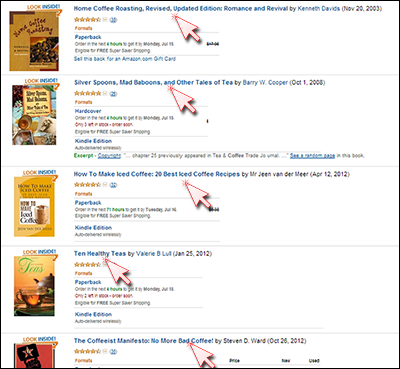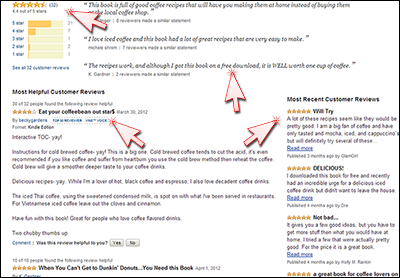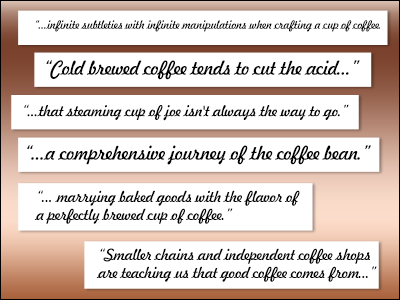Being innovative is one way to get ahead at copywriting. Innovation involves observing what’s going on around you and then finding ways to use your observations to your advantage. One of the ways I’ve used this concept is by studying the Amazon Marketplace. When I need help structuring a piece of copy, I’ll visit Amazon to observe the social habits of people—what they buy, sell, and discuss. Let me show you how.
Search the “Books” Category
The first step is going to Amazon.com and searching under the “Books” category. You can search for anything you want. In my example, I will use “coffee” as my search term.
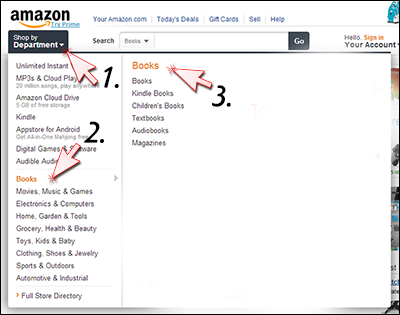 Finding the “Books” section at Amazon.com is easy. Click on “Shop by Department” (1). This will drop down a list of departments, one of which is books. Click on “Books” (2) and Amazon will display book categories as well as book formats (3).
Finding the “Books” section at Amazon.com is easy. Click on “Shop by Department” (1). This will drop down a list of departments, one of which is books. Click on “Books” (2) and Amazon will display book categories as well as book formats (3).
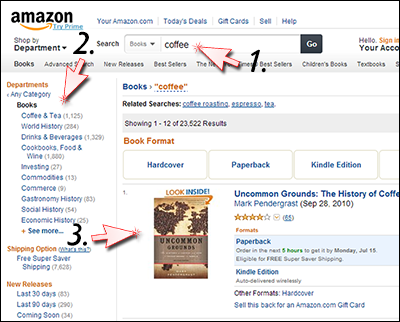 For this example, I searched for “coffee” (1). In the left navigational column (2) Amazon breaks down all of the coffee book categories. In the center of the webpage is the information about the product (3).
For this example, I searched for “coffee” (1). In the left navigational column (2) Amazon breaks down all of the coffee book categories. In the center of the webpage is the information about the product (3).
Scan the Top Book Titles
Once you have the search results, scan the top 100 book titles. Pay attention to the wording the titles use. Although this might be time consuming, the top 100 titles will help you formulate a strong headline for your copy because Amazon will show you what’s popular, and what’s not. I find this method more effective than using Google Adwords Keyword Tool because Amazon shows you what products people are paying money for, whereas Google’s tool only reveals the most popular search terms that people are using.
After browsing through the top 100 results for “coffee” under the “Books” category, I was able to formulate the following headline: How to Make Coffee So Good You’ll Put Starbucks out of Business. If I were to write a book or article about this topic, I would use a picture of a Starbucks with a “Going out of Business” sign. The inspiration for this headline and picture was gained responsively as I scanned the top 100 titles and covers. The process took less than ten minutes, and I was able to get an idea that I normally would not have.
Scrolling through best-selling book titles can help you determine what words and/or phrases attract interest from readers.
Amazon is not just helpful for creating better headlines—it can help you figure out what people are thinking and feeling. When you know about people’s likes and dislikes about a certain subject or product, you can learn how to write more engaging copy that appeals to their emotions.
Amazon has spent a fortune—hundreds of millions of dollars—building up their marketplace that is driven by the buying and selling of goods. Both new and loyal customers decide what to purchase based on the inputs of others (i.e., word of mouth). Customer reviews are what fuel the Amazon machine.
Look at Customer Reviews
Customer reviews of products are a main staple of Amazon—customers rely on reviews to help them decide what and what not to purchase. A single product page will have its own customer reviews on the left side, in the middle, on the right side, and below.
I’ll now show you how to use the reviews to your advantage using my “coffee” example. What I do is look at what results have the most reviews and open them up in different tabs; however, you may choose to work on each result one by one. One thing to note is although you can sort the results by “Most Reviewed,” this often leads to books showing up that have nothing to do with your search term. Once you are at the reviews portion of the product, you’ll notice that each review is rated one to five stars. You will want to ignore the two, three, and four star reviews. What is most relevant to you, as a copywriter, are the one and five star ones. The two, three, and four star reviews usually indicate that people are uncertain about how they feel—you only want the reviews from people who have a strong emotional response.
As you read some of the five star reviews, you will begin to have a clearer idea of what your “copy points” will be. Pay attention to how reviewers explain what they consider most important to them—they usually talk about the specific reasons why they had rated the product five stars. Oftentimes they will write a personal story to convey their appreciation or talk about specific details that you normally would not think of as a copywriter. These response are copywriting gold…gold that you can use to forge your own unique piece of copy; they allow you to base your copy on what is important to people.
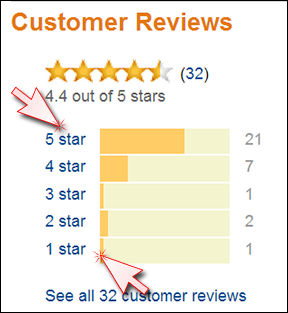
One star reviews can help you as much as five star reviews because they both reveal reviewers’ strong positive or negative emotions.
It’s not just the five star reviews that you should read, the one star reviews are just as relevant. The one star reviews tell you what to avoid (i.e., the weaknesses and problems of the product). When writing about that particular subject, you can address these problems, and provide solutions for them, in your copy.
This is I how I go about this process: as I am reading through the five and one star reviews, I’ll copy and paste certain phrasings and words that stand out for me into two notepad documents—one for the five star reviews and one for the one star reviews. When I am writing my copy, I reference and delete them one by one. Before I know it, I have a generated piece of copy that is based on the strong emotional response of people. Did you just hear that three pointer swish sound? I sure did.
A few random phrases and words from customer reviews that caught my attention and gave me ideas for writing stronger copy related to coffee.
Once you have this information, it’s up to you to decide what to do with it. The important part of this article was to point out how to gain valuable “insider” information to help you write stronger copy. This information can help you save hours, if not days, of time.
One last takeaway: not only can you use Amazon reviews to help you write engaging copy, but you can also use this strategy on other sites like Yelp, the Apple store, Epinions.com, or any site that offers customer reviews.
Now, go forth and take this new insight and produce some awesome copy.
(Amazon.com® and the Amazon.com logo are the registered trademarks of Amazon.com, Inc. Amazon screens courtesy of Amazon.com for informational purposes only.)
About the author:
 Raymond Duke is a freelance copywriter who is just getting his feet wet in the business. Although new to the field, he has been having much success. He attributes his positive start to the many years spent writing on his website (which he has turned into a front for his copywriting services), and his B.A. in Interpersonal and Organizational Communication. Raymond can also be reached on Twitter @raymondduke.
Raymond Duke is a freelance copywriter who is just getting his feet wet in the business. Although new to the field, he has been having much success. He attributes his positive start to the many years spent writing on his website (which he has turned into a front for his copywriting services), and his B.A. in Interpersonal and Organizational Communication. Raymond can also be reached on Twitter @raymondduke.
